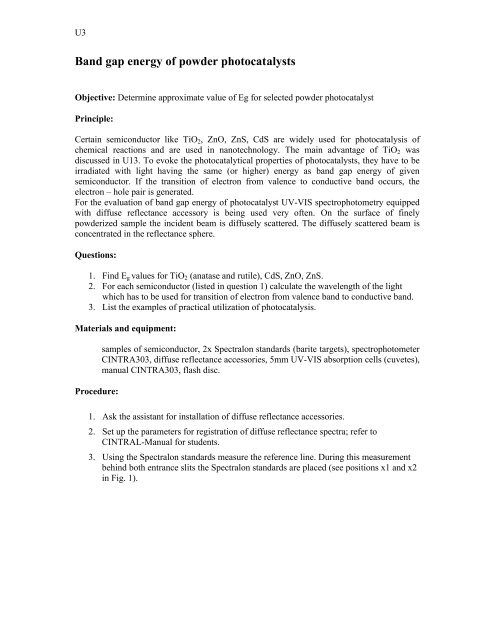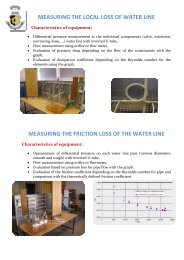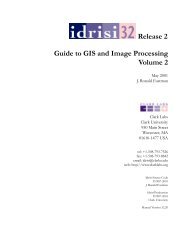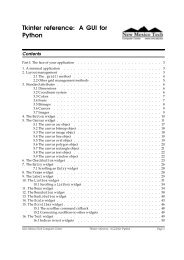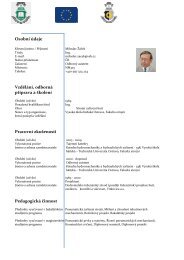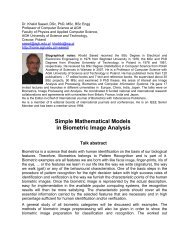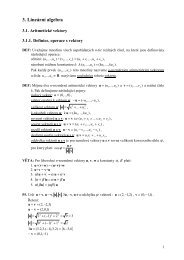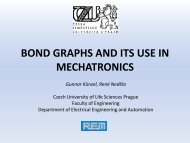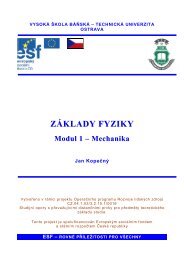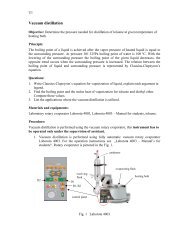Band gap energy of powder photocatalysts
Band gap energy of powder photocatalysts
Band gap energy of powder photocatalysts
You also want an ePaper? Increase the reach of your titles
YUMPU automatically turns print PDFs into web optimized ePapers that Google loves.
U3<br />
<strong>Band</strong> <strong>gap</strong> <strong>energy</strong> <strong>of</strong> <strong>powder</strong> <strong>photocatalysts</strong><br />
Objective: Determine approximate value <strong>of</strong> Eg for selected <strong>powder</strong> photocatalyst<br />
Principle:<br />
Certain semiconductor like TiO 2 , ZnO, ZnS, CdS are widely used for photocatalysis <strong>of</strong><br />
chemical reactions and are used in nanotechnology. The main advantage <strong>of</strong> TiO 2 was<br />
discussed in U13. To evoke the photocatalytical properties <strong>of</strong> <strong>photocatalysts</strong>, they have to be<br />
irradiated with light having the same (or higher) <strong>energy</strong> as band <strong>gap</strong> <strong>energy</strong> <strong>of</strong> given<br />
semiconductor. If the transition <strong>of</strong> electron from valence to conductive band occurs, the<br />
electron – hole pair is generated.<br />
For the evaluation <strong>of</strong> band <strong>gap</strong> <strong>energy</strong> <strong>of</strong> photocatalyst UV-VIS spectrophotometry equipped<br />
with diffuse reflectance accessory is being used very <strong>of</strong>ten. On the surface <strong>of</strong> finely<br />
<strong>powder</strong>ized sample the incident beam is diffusely scattered. The diffusely scattered beam is<br />
concentrated in the reflectance sphere.<br />
Questions:<br />
1. Find E g values for TiO 2 (anatase and rutile), CdS, ZnO, ZnS.<br />
2. For each semiconductor (listed in question 1) calculate the wavelength <strong>of</strong> the light<br />
which has to be used for transition <strong>of</strong> electron from valence band to conductive band.<br />
3. List the examples <strong>of</strong> practical utilization <strong>of</strong> photocatalysis.<br />
Materials and equipment:<br />
Procedure:<br />
samples <strong>of</strong> semiconductor, 2x Spectralon standards (barite targets), spectrophotometer<br />
CINTRA303, diffuse reflectance accessories, 5mm UV-VIS absorption cells (cuvetes),<br />
manual CINTRA303, flash disc.<br />
1. Ask the assistant for installation <strong>of</strong> diffuse reflectance accessories.<br />
2. Set up the parameters for registration <strong>of</strong> diffuse reflectance spectra; refer to<br />
CINTRAL-Manual for students.<br />
3. Using the Spectralon standards measure the reference line. During this measurement<br />
behind both entrance slits the Spectralon standards are placed (see positions x1 and x2<br />
in Fig. 1).
U3<br />
1<br />
2<br />
Fig. 1 a) installation <strong>of</strong> diffuse reflectance accessory, b) positioning <strong>of</strong> sample to diffuse<br />
reflectance accessory<br />
4. Pour carefully the sample to measuring cuvete. Clean the outer side <strong>of</strong> cuvete.<br />
5. Replace the Spectralon standard in position 1 with sample in cuvete.<br />
6. Measure diffuse reflectance spectra <strong>of</strong> samples, for measurement refer to manual.<br />
7. Import the measured data (*.csv format), the data are imported in two columns – 1 st -<br />
wavelengths, 2 nd - relative reflectance.<br />
8. Using EXCEL (or using other s<strong>of</strong>tware) perform the evaluation <strong>of</strong> the measured data:<br />
multiple measured reflectance with the value 100 (the reflectance is now expressed in<br />
the form <strong>of</strong> %), next construct the relationship Reflectance(%)=f(wavelength).<br />
Translate the wavelength values to <strong>energy</strong> in eV, construct the relationship<br />
Reflectance(%)=f(E).<br />
9. Perform the Kubelka-Munk transformation <strong>of</strong> measured reflectance (according to eq.<br />
1).<br />
2<br />
(1 R)<br />
K (1)<br />
2R<br />
where K is reflectance transformed according to Kubelka Munk, R is reflectancy (%).<br />
2<br />
10. Construct the relationship ( K * h<br />
) f ( h * ) [1] - (see Fig. 2).<br />
11. Find the E g value.<br />
1<br />
[1] J. Tauc, R. Grigorovici and A. Vancu, Phys. Status Solidi 15 (1966), p. 627.<br />
Conclusion:<br />
Summarize the measurement, list the found E g values and comment them.<br />
Acknowledgement:<br />
Author tanks to RNDr. J. Jirkovský, CSc. from J. Heyrovsky Institute <strong>of</strong> Physical Chemistry for consultation<br />
with interpretation <strong>of</strong> diffuse reflectance spectra.
U3<br />
5,5<br />
5,0<br />
4,5<br />
4,0<br />
(K*h) 1/2 [eV 1/2 ]<br />
3,5<br />
3,0<br />
2,5<br />
2,0<br />
1,5<br />
1,0<br />
E g<br />
0,5<br />
0,0<br />
5,0 4,5 4,0 3,5 3,0 2,5 2,0 1,5 1,0<br />
h* [eV]<br />
2<br />
Fig. 2 Relationship ( K * h<br />
) f ( h * )<br />
1


